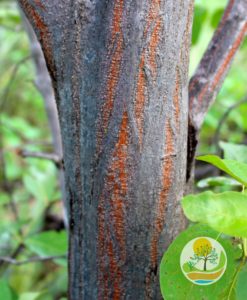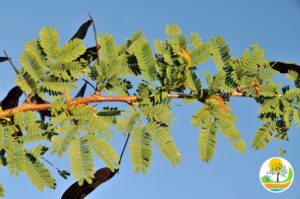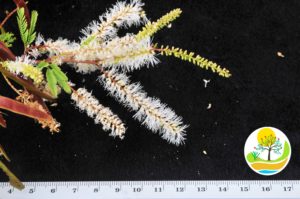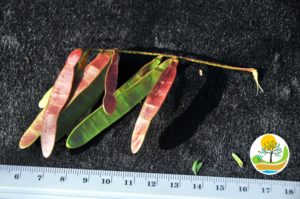General information
Summary description
Endemic species of Brazil. In natural areas of Caatinga and anthropized areas.
Scientific nomenclature
Mimosa ophthalmocentra Mart. ex Benth.: Class Equisetopsida C. Agardh, Sub Class Magnoliidae Novák ex Takht., Super Order Rosanae Takht., Order Fabales Bromhead, Family Fabaceae Lindl, and Genre Mimosa L. (TROPICOS. ORG, 2018).
Local names
Jureminha, jurema-branca, jurema-de-embira, and jurema-de-imbira (DUTRA, 2015).
Cultural and economic importance
Its leaves and pods are eaten by sheep, goats, and cattle. It present an edible resin, recommended for treatment of flue (SILVA, 2006).
Ecological importance
Pioneer plants, making association with rhizobia in their roots – nitrogen fixing-bacteria.
Phenology
The Projeto Caatinga keep track of 10 samples of Jurema-de-Embira in a Nature Reserve in the city of Upanema-RN. In preliminary results regarding budding and defoliation, we observe that the leaf loss increases in the months near the summer season (Nov, Dec, Jan), which is the driest and hottest period of the year in the Caatinga. Fruits all year long, from the Spring, with an increase in the Winter (decreasing until the Autumn and the beginning of Summer).

Left chart: defoliation (red) and budding (green) from May to November. Right chart: fructification (red) and flowering (green) from May to November.
Geographical distribution
In the Northeast (Caatinga): states of Bahia, Ceará, Paraíba, Pernambuco, and Rio Grande do Norte); Mid-West region (Federal District), and Southeast region (state of Minas Gerais) (TROPICOS.ORG, 2018).
Botanic description
Size, crown shape, color, growth habit
It is classified as a shrub, and according to Flora do Brasil (2018) may reach 3 to 6 m (9.8 to 19.6ft). Sparse and globous crown with leaves in dark green.
Vegetative characteristics
- Trunk and bark
Rough trunk with straight thorns. Gray brownish thin bark, with reddish streaks and yellow lenticels (SILVA et al., 2011).
- Leaves
Alternate leaf arrangement, bipinnate, with two to four pinnae and 15 to 22 leaflets per pinna (SILVA et al., 2011).
- Flower/inflorescence
Small white to cream-color flower, monoicous. Auxillary inflorescence, short pedicel (SILVA et al., 2011).
- Fruit, seeds and dispersal syndrome
Dry fruits. Wavy and reticulated surface, glabrous. (CORDULA; MORIN; ALVES, 2014).
Seeds with pleurogram. Seed dispersal by explosion (CORDULA; MORIN; ALVES, 2014).
Seed technology
Results from studies with seeds of Jurema-de-Embira (Projeto Caatinga) are reported below:
Germination
Seeds from seven different mother trees harvested nearby Mossoró in 2017 showed a germination percentage above 95% in paper, with an average of 98%.
Seed storage
After six months of storage (in cold chamber and at room temperature), using different containers, seeds presented 95% of germination.
Seed health
In assessments with M. ophthalmocentra seeds, researches of the Projeto Caatinga identified the following fungi attacking the seeds: Aspergillus, Cladosporium, and Rhizoctonia. A comparison was made between seeds disinfected superficially and non-treated seeds.
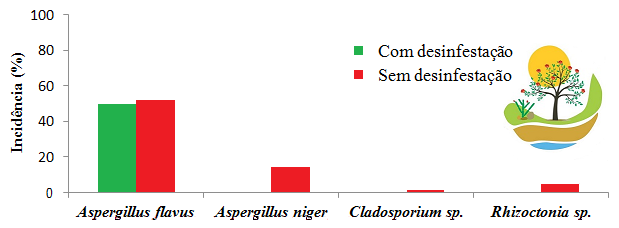
Fungi incidence in seeds of Mimosa ophthalmocentra. (Disinfected seeds in green; non-treated seeds in red).
Disinfected seeds showed an incidence of 50% of the Aspergillus flavus fungi, while non-treated seeds had a higher incidence of A. flavus (52%), followed by Aspergillus niger (14%), Rhizoctonia sp. (5%), and Cladosporium sp. (1%). Seed disinfection reduced fungi diversity in this species.

Fungi associated to seeds of Mimosa ophthalmocentra. A) Aspergillus flavus B) Aspergillus niger C) Cladosporium sp. D) Rhizoctonia sp.
Cladosporium and Rhizoctonia may cause diseases in some species, such as leaf spots and rot. They were observed in some native species (Angico, Pereiro, Sabiá, and Canafístula) (SENEME, 2012; LEITE, 2013).
Seedling production
Results from studies with seedlings of Jurema-de-Embira (Projeto Caatinga) are reported below:
Growth capacity
Plants response to organic matter incorporated in the substrate was good, resulting in higher plants, more number of leaves and greater stem diameter.

CHARTS – Left: height; Center: leaves; Right: stem diameter. (Incorporated organic matter in green; no organic matter in red).
< Go back to main page >
REFERENCES
- CORDULA, E.; MORIN, M. P.; ALVES, M. Morfologia de frutos e sementes de Fabaceae ocorrentes em uma área prioritária para a conservação da Caatinga em Pernambuco, Brasil. Rodriguésia, Rio de janeiro, v. 65, n. 2. 2014.
- DUTRA, V. F., MORIM, M. P. Mimosa in: Mista de Espécies da Flora do Brasil. Jardim Botânico do Rio de Janeiro. 2015.
- SILVA, L.B. et al. Estudo comparativo da madeira de Mimosa ophthalmocentra Mart. ex Benth e Mimosa tenuiflora (Willd.) Poir. (Fabaceae-mimosoideae) na Caatinga nordestina. Acta Bot. Bras., Feira de Santana, vol. 25, n. 2. 2011.

